| |||||||
| Search Forums |
| Advanced Search |
| Go to Page... |
 |
| Search this Thread |  95,868 views |
| | #1 |
| Senior - BHPian Join Date: Oct 2014 Location: Mumbai
Posts: 1,152
Thanked: 8,574 Times
| Report, Pics & Video: Bajaj Pulsar RS200 ridden at the factory test-track The Bajaj Pulsar RS200 has been launched in India at a price of between Rs. 1.18 - 1.30 Lakhs (ex-Delhi). NOTE: This is not a road test. The RS200 has only been ridden on Bajaj's test track (and not in real world conditions).  The Bajaj Pulsar was born out of the brand’s desire to beat the status quo. Lifestyle motorcycles were rare and two-wheelers were mainly used for affordable commuting. In 2001, Bajaj brought in the Pulsar with 150cc and 180cc engines, in an age where 100cc bikes were the norm (Royal Enfields being the only exception). The Pulsar name was pushed with the “Definitely Male” tag to associate the bike with the Indian man’s macho pride. Among the other bikes that had such a strong fan base was the Hero Honda CBZ (1999). The first model was a bulky tanked machine with a round headlamp and instrumentation that gave it a butch appeal. The next Pulsar was brought in 2003 and featured DTS-I technology (digital twin spark ignition). It also came with the “bikini headlamp” & twin pilot lamps. The Pulsar was then refreshed in 2004. Upgrades included new 17-inch alloy wheels, ExhausTEC (Patented Bajaj tech to improve low end power delivery) and nitrox shock absorbers. August 2005 saw the arrival of the all black series. In 2006, the bike got features like a digital speedometer, LED tail light, self-cancelling turn indicators, backlit switches and a redesigned headlamp.  In 2007, Bajaj launched the Pulsar 200 with split seats, split grab bars and tubeless tyres. The same year saw the arrival of the semi-faired Pulsar 220 DTS-FI which brought in projector headlamps, a rear disc brake and fuel injection. In the years that followed, the Pulsar got a few minor changes and new variants, such as the 135 LS and carburetted Pulsar 220 in 2009. The most significant development came in 2014, when the CS400 and SS400 concepts were showcased.  Since then, what followed, was a bombardment of spy shots of a similarly styled test mule, which was promptly labelled the SS400. This was then switched over to the SS200, before the bike was finally confirmed as the “Race Sport” or RS200. Bajaj launched the RS200 on March 26th at Rs. 1.18 Lakh for the non-ABS version and Rs. 1.30 Lakh for the ABS variant. The RS200's styling has a lot going on. Looks are guaranteed to polarize opinions:  On first impressions, what strikes you the most, is the fact that the design is nearly identical to the SS400 concept. In fact, except for a few panel colour alterations, the RS200 and SS-Concept are practically the same! Commendable job by Bajaj indeed (all those spy shots for a design we already saw *sigh*). The RS200’s looks are quite polarizing. Either you love it or you hate it – there is no middle ground. Bajaj’s clientèle has become younger over the years and the designers have made the bike get more edgy with each successive model. I’ll be honest, when I saw the bike in pictures, I wasn’t a big fan. The colours and graphics scream 'look-at-me' and the sheer number of cuts, edges and sharp dives in the bodywork, make the styling borderline distracting. The inappropriate tagline “leave track racing to amateurs” made me question the intention behind the loud styling as well. However, in the metal, the RS200 is quite approachable. There is no doubt that the bike will turn heads and will easily connect with its target audience. Up front, we see an eagle’s beak-like design to the front fascia. The black and white stickering acts like eyebrows for the aggressively placed projector headlamps. The horizontally placed projectors are garnished with LED pilot lights on top with silver accents below. The fascia also features black rear view mirrors with a transparent wind deflector bolted on by 6 fat screws. The side profile is by far the busiest angle of the RS200 and looks like something a samurai tested his sword on. The sheer number of edges and contrasting contours make it hard to pinpoint one facet to appreciate. The perimeter frame, lower half of the fuel tank, flanks, side panels and engine guard are all black, contrasted by red or yellow on the fairing, fenders and fascia. The black end on the tank has a carbon fiber look, though the finish itself is smooth. The side panels are actually made of a perforated plastic mesh. A similar fitment is seen on the front fairing and their integration helps improve air flow for better aerodynamics and engine cooling. The side profile also sports a new bulky exhaust, as opposed to the underbelly set up on the 200 NS. One overwhelming design facet would have to be the stickering. Combined with the low-cost hard plastic finish on the fenders - the graphics on the mud-guard, fairing and fenders just make things look tacky. Move to the back and you see the large boomerang shaped “crystal” LED tail lights. The cluster faces upwards and honestly comes off as raunchy in terms of styling. The size of the tail light cluster is dauntingly large and the set up extends a fair bit beyond the body. The number plate and reflector extend further back and make the bike look longer than it actually is. While the front styling isn't subtle by any standard, it is still edgy and appealing. The rear on the other hand, is just trying too hard. The rear tyre still gets an ugly tyre hugger and it’s not a feature many people will appreciate. Over to the cockpit and the RS200 really shines. The RS200 is Bajaj’s counterpart to the KTM RC 200, but is evidently not as sporty. The fairing makes the bike properly chunky and it has enough bulk to cast a shadow on your knees. Speaking as a cruiser rider, I love it, but I’m not sure how much the crotch rocket fans will appreciate this. One more nuance that comes with Bajaj’s first fully faired Pulsar is an evident number of screws. The screws have been decently integrated on most of the outer panels, but once on the saddle, there’s no ignoring the ones that garnish the tank & instrument cluster housing. The instrument cluster has been lifted straight off the 200 NS and there’s a fair bit of information on display for the rider. Not to mention, the layout is a lot more visually pleasing than that of the RC200. You get warning lights to the left, an analogue tachometer with an integrated digital fuel gauge in the middle, a digital speedometer to the right, along with a host of other information, including two trip meters. The main difference over the 200 NS though, will be seen only with the ABS variant as you get an ABS warning light... and no, the ABS doesn't get the option of deactivation (like say, the Duke 390 & Apache RTR 180). Overall, the styling isn’t as stately or straightforward as the Honda CBR 250R, nor does it have the class of the RC 200's exteriors. There is no doubt that the RS200's design is revolutionary and will grab attention effortlessly. The looks will invite some flak at first, but it's sure to grow on you over time. This alone will prove as an incentive to buy the bike, but the question remains as to how long the novelty will last. Black and grey panels from the concept get dropped for similarly coloured stickers: 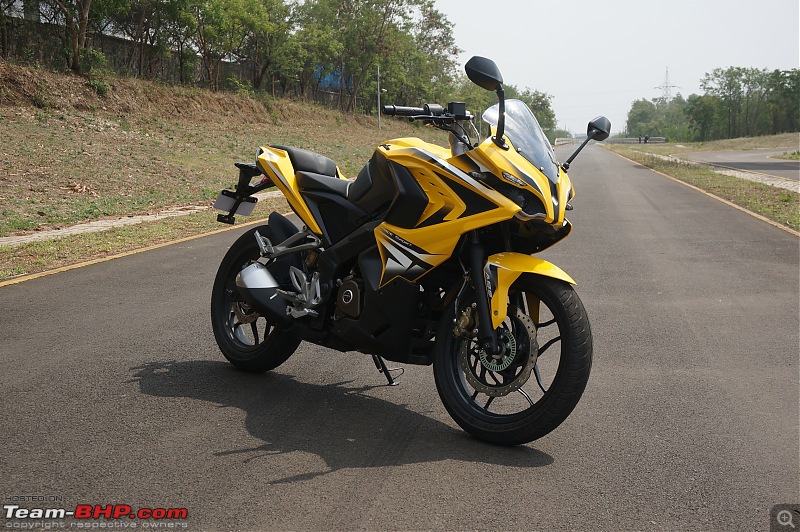 While the front end is bulky, the design gets slimmer as you move rearward: 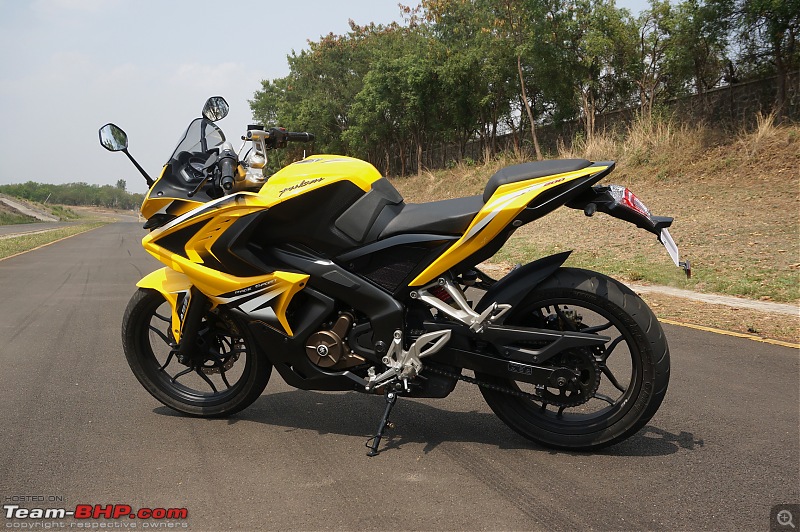 "Crystal" LED tail-lamps extend beyond the body. Some might feel that the styling is overdone:  The projector headlamps add strong expressionism to the fascia:  Note the eagle's beak-like inward curve: 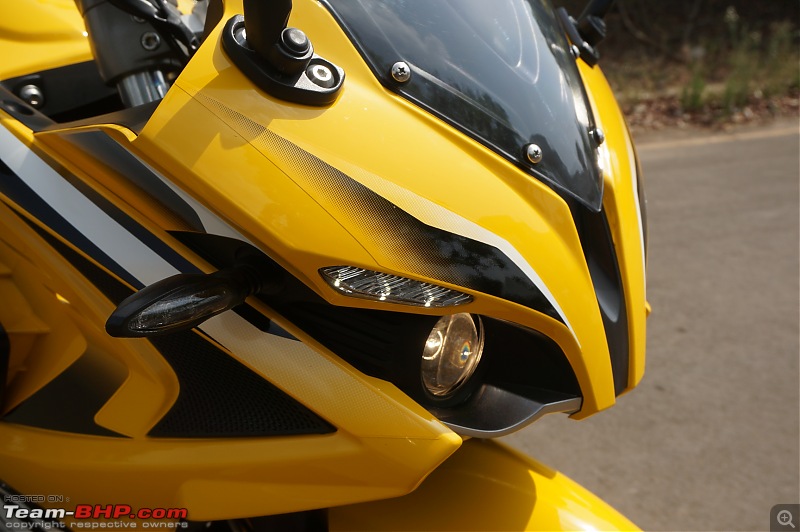 Wish Bajaj had not opted for the regular beam being a single light. It looks rather odd with the DRLs: 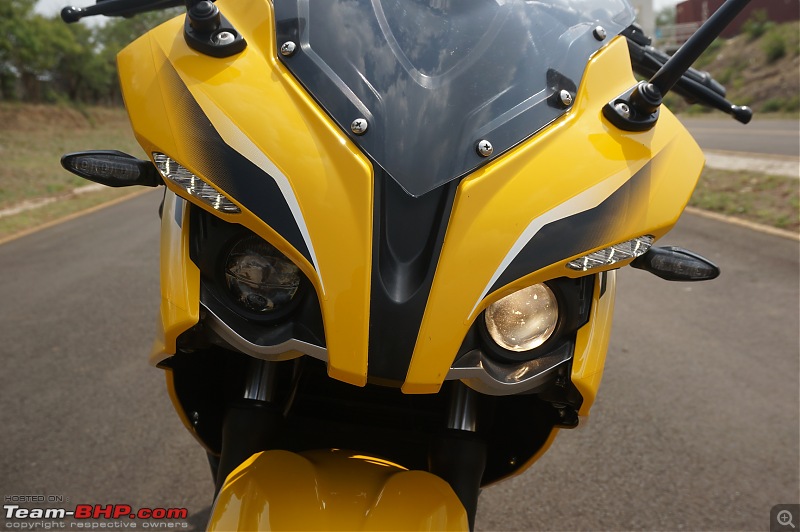 65W high beam projector (L) and a 55W low beam projector (R). Also notice the large screws holding the wind deflector in place: 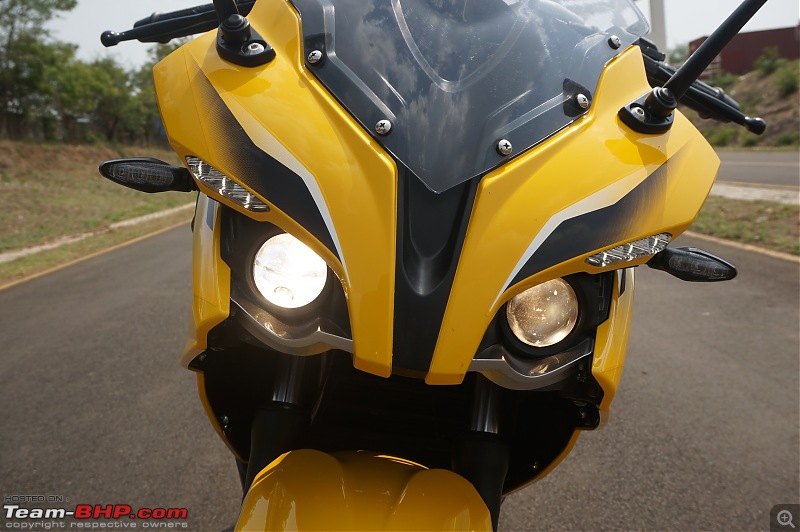 Sleek indicator lights may not be easy to spot for oncoming traffic/pedestrians, due to the overshadowing bulk of the fascia:  Black ORVMs. They offer great visibility even for riders with a broad frame:  300 mm disc brake with steel braided lines. Optional single channel ABS costs an additional Rs. 12,000: 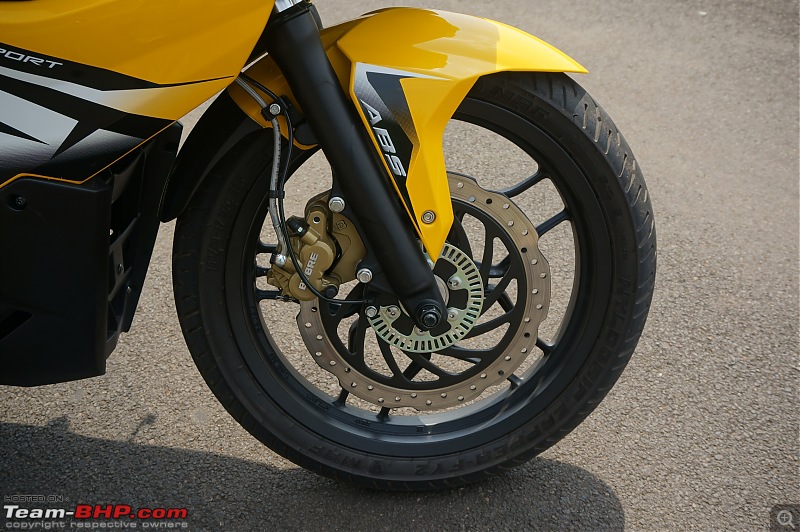 17-inch alloy wheels have the same pattern as the 200 NS: 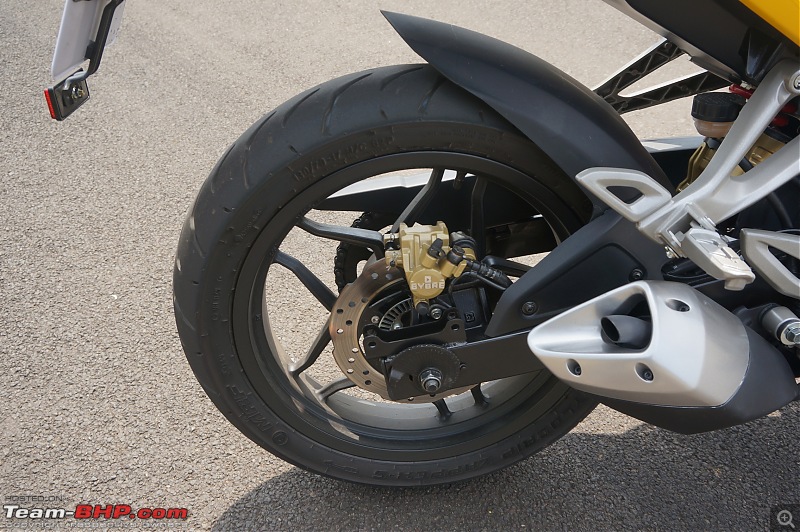 Chunky heat shield doesn't integrate perfectly with the actual tail pipe:  Pillion seat drops the grab rails (of the NS) for recesses:  Grip recesses are deep enough for your fingertips, but the hard quality plastic means you're better off holding onto the rider. A little padding would've gone a long way here:  Fortunately, the pillion seat isn't two floors above the rider's seat like in the Yamaha R15:  Carbon fiber like pattern on the tank has a smooth finish:  Pulsar branding is flaunted proudly on the tank:  A soft scratch guard that doubles up as an inner thigh cushion:  The side panel is a perforated mesh:  The instrument cluster is the only place where the Bajaj logo is seen (apart from the engine). Unit has been lifted off the NS:  The off-center ignition keyhole:  Backlit switches will look amazing at night: 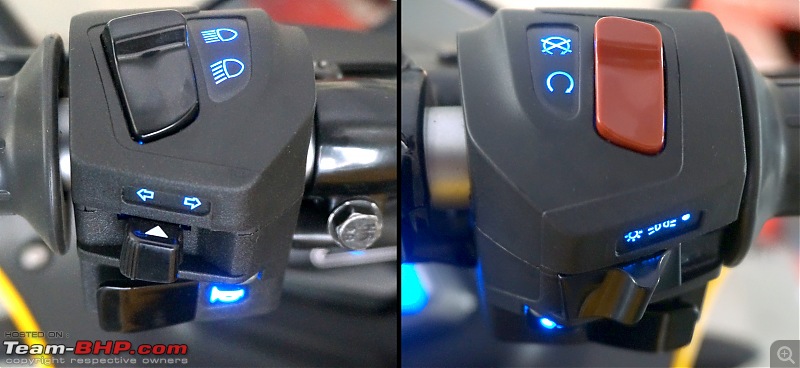 No storage space whatsoever. According to the dealer, park the documents here (below the pillion seat):  Batman and Bumblebee - vertically placed headlamps on the 220 vs the horizontal layout of the RS200:  Note how the P220’s face is “pulled back” in comparison to the flatter RS200 fascia:  The RS200 gets a tyre hugger (Bajaj took it off the test bikes). A mudguard like the 220’s would look better:  Last edited by Aditya : 24th April 2015 at 08:19. |
| |  (22)
Thanks (22)
Thanks
 |
| The following 22 BHPians Thank Tushar for this useful post: | Aditya, condor, dreamliner17, fusionbang, ganesc, globemaster, GTO, Ikoner_03, InControl, Insearch, JoseVijay, manson, Mashblue, PM - B, Rehaan, rki2007, rshanker, S2!!!, swiftnfurious, theexperthand, VeluM, Vid6639 |
| |
| | #2 |
| Senior - BHPian Join Date: Oct 2014 Location: Mumbai
Posts: 1,152
Thanked: 8,574 Times
| The Track An image of the track from Google Earth:  Bajaj's test track at Chakan, Pune has been developed to create bikes for India & global markets. The track does not offer a variety of terrain conditions; it has been designed primarily to test a machine's performance and handling capabilities on smooth roads. The road is completely flat and there isn't any steep gradient either, much like a proper race track. The entire area is monitored by several CCTV cameras that relay the feed to a control room located in the pit lane. Out of the pit lane, you begin with a mildly curved stretch that culminates into a series of 'S' bends that inspire knee-scraping turn-ins even at speeds as low as 40 km/h. This area is appropriately labelled the S-section. After around six varied angle turn-ins, you hit the first straight that's ~750 metres in length and ride into a sharp hairpin bend that will get you on your knee at speeds of 70-95 km/h. It is labelled the D-section. This spot is bordered by a yellow marking on the banking and riders are to steer clear of that border, as even mild braking inputs can cause the bike to lose traction. Riders need to exit the bend as fast as possible to make the best use of what comes next. Much like the lead up to the main straight at VW's Ehra-Lessien test track, the bend exits into the Chakan track's 'L' straight. This is where top speeds are measured and where riders go flat out, begging the speedo to keep rising. Riders need to be in the most streamlined posture and tuck themselves into the bike properly. It's named the L-straight because the track takes a sharp turn at the end where the bike's braking (both engine and regular) can be put to the test. It's also a great section to test the steering precision and feedback at higher speeds. The track then has a light angle that passes by the pits and re-enters the S-bends. Riders (3 at a time) had around 20 minutes on the track - anyone without track racing experience would truly appreciate the level of concentration, energy and alertness that professional racers require. The main entrance to Bajaj's production plant at Chakan, Pune: 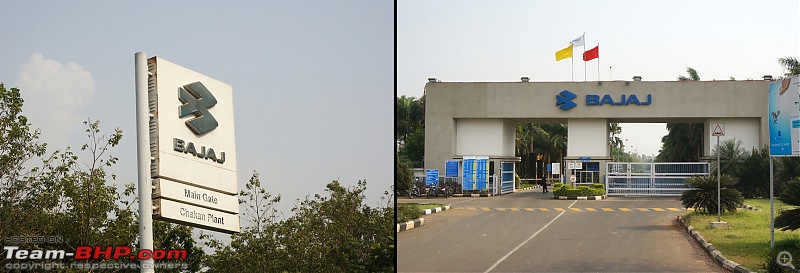 The pitlane:  Entrance from the pits to the track. This section leads into a series of S bends:  The top left is where riders exit the track and enter the pitlane:  The main straight. Long enough that you can't see the other end: 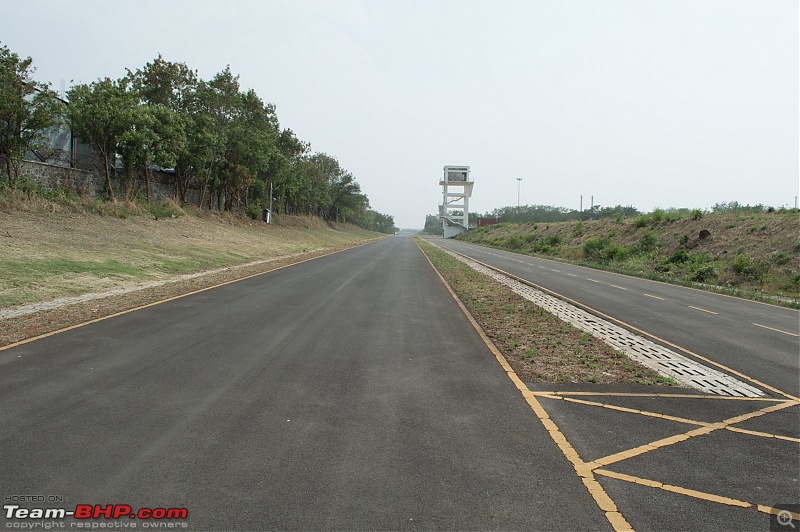 This curve at the end of the L-straight is tricky. It's not very sharp, but you enter this point at the highest possible speed. Judgement errors are likely, so there's a small "run-off" road that goes straight as a safeguard:  Last edited by Aditya : 24th April 2015 at 09:52. |
| |  (19)
Thanks (19)
Thanks
 |
| The following 19 BHPians Thank Tushar for this useful post: | Aditya, condor, dreamliner17, fusionbang, ganesc, GTO, InControl, JoseVijay, manson, Mashblue, Rehaan, rki2007, rshanker, S2!!!, swiftnfurious, theexperthand, Turbo_asd, VeluM, VijayAnand1 |
| | #3 |
| Senior - BHPian Join Date: Oct 2014 Location: Mumbai
Posts: 1,152
Thanked: 8,574 Times
| The Riding Experience  A track test for a bike whose tagline says "leave track racing to amateurs”  . . Since I rode the RS200 only on track, real world maneuverability will have to be judged by a proper road test later. It is also important to note that none of these bikes had run more than 300 - 400 kms, thus the engines weren't properly run in yet.  The RS200 may have been seen simply as a faired 200 NS, but there’s a lot more than what meets the eye. Power comes from a 199.5cc, single-cylinder, 4-valve, triple spark, fuel injected motor. Output figures come in at 24.2 BHP @ 9,750 rpm and 18.6 Nm of torque @ 8,000 rpm. The engine is mated to a 6-speed manual transmission. The main difference over the engine of the 200 NS is the fact that the RS200 gets fuel injection, with the power & torque going up by 1 BHP & 0.3 Nm respectively. The engine is the same one used by the 200 NS, dropping the carburetor for a fuel injection system:  Although the bike is fully faired, there are several gaps and openings for ventilation:  The coolant reservoir can be seen near the handlebar:  Get on the saddle and at lift off, there’s little to differentiate the RS from its naked sibling. To get moving from a stop, you need to get the needle between 2,800-3,000 rpm. Anything lower and the motor doesn’t need much incentive to stall. The fairing certainly has an impact on the dynamics and the bike’s bulky proportions become apparent on the get go. However, once you enter cruising speeds, the RS200’s individuality begins to creep in. The first thing that strikes you is the rev happy nature of the engine. The fuel injector makes each stroke more refined and the bike’s impatience to climb up the tacho is very enjoyable. The RS200’s thrust through the speedo though isn’t something that will knock your socks off. The acceleration is linear with a sense of urgency, yet it won’t be daunting to ride, even for a first timer. The output figures are certainly respectable, but this is a short stroked engine and the meat of the performance comes in between 5,500-8,000 rpm. In fact, attempting to reach 9,750 rpm (where it develops peak horsepower) will easily make the rev limiter warning go off a millisecond later (it flashes as soon as you cross 10,000 rpm). What I liked a lot about the RS200’s performance is that it has been calibrated intelligently. While the styling screams of aggression, the performance is satisfying yet approachable. For instance, revving the bike hard to up the pace will receive no protest and unlike the Honda CBR 250R, there is no engine cut off. There isn't much caution required while going all out; though the approach to the redline is quick, it takes some serious focus to make the limiter flash go off. This isn't a superbike, so hitting the 11,000 rpm limit is an act of focused deliberation (unlike the CBR 250R which hits the revv cut-off easier). What’s also pleasing is the exhaust note that bellows from the chunky side-pipe. The sound still has the familiarly crude gurgle that you expect from a Bajaj, but there’s no doubt that the grunt is appealing to the ears, especially when you compare it to the nasal KTM burble. Refinement levels have improved as well and I personally believe that Bajaj can reach Japanese levels of fine-tuning in another 2-3 years. At least when new, the bike has absolutely no noise apart from the engine itself. There is no squeaking from any part of the body, nor do you hear the chain drive. Though I still have my apprehensions when it comes to Bajaj motorcycles in the longer term, all this inspires more confidence in the bike's structural integrity and encourages you to make your lower wrist go south and push harder. I, of course, obliged and managed to hit a speedo indicated 145 km/h, while some others crossed 150 km/h. These numbers are prone to speedo errors as Bajaj states the top speed as 140.8 km/h. At some point, I had to slow down and when I did, it immediately became apparent that this bike has been calibrated for everyday use. It just felt so much more at home in the 70-100 km/h range than it did while attacking the corners hard. The suspension is soft, and the terrain doesn't feed through the body much. While this could prove to be just right for everyday urban conditions, it's not ideal for the track. For example, taking a hard curve at high speeds will see the bike offering a bit more dampening than you'd want. The rear mono-shock is adjustable and quite stable (factory setting is ideal IMO), but the front forks are definitely inclined to provide more comfort than precision. The steering too has a moderately sharper angle than the 200 NS, although it doesn't offer the pinpoint focus that would make it a perfect track machine. The telescopic front suspension with an anti-friction bush channels a decent amount of feedback to the handlebars. Still, it does require consistent and minor corrective steer to make it go exactly where your eyes are looking. In that sense, the rear nitrox monoshock is rather stable and offers limited rebound even in knee scraping turn-ins. The riding position is relaxed and you don't have to work on your core to avoid putting your weight down on your wrists. To put things into perspective, if you consider the CBR 250R's seating stance good for touring, the RS200 is even better. What might not aid the touring capability is the finish quality of the handlebar grips. They are quite hard and six laps into riding on the track, my inner palm was in pain. However, the grips will offer good protection against slippage. The initial lot of gears (especially 1st & 2nd) are short and getting into 3rd won’t take you much time. It is here that the ratios become easier to live with. 4th and up are taller - as long as you keep it above 5,000 rpm, the RS200 can offer good cruising abilities as well. Bear in mind that this bike is meant for quick shifting, so slowing down will easily see the bike choking for a downshift on most occasions. Under hard riding scenarios, managing engine braking is more amateur rider-friendly. For example, while approaching a hard bend on the track, I was doing about 143 km/h (speedo indicated). At that speed in 6th gear, you are at the 11,000 rpm mark, which means popping the lever too fast will lock up the rear wheel with ease. However, there is a slight delay before the clutch latches onto the next gear and the lever has about 1 inch of "error play"... giving you a precious 1-2 seconds more to analyze your next move, if you get the sense you've downshifted too soon. The perimeter frame has been designed to offer higher levels of stiffness and minimal flex. This properly reflects in the stability of the bike, so while hard downshifts will have an expected level of strain on the powertrain, the bike's shell remains stable as a rock. The RS200 piles on 20 kgs over the 200 NS and is a good 165 kgs heavy. While it's taxing to push around, the weight isn't ever felt while riding. Even while maxing out the speedo in the 140-150 km/h range, the RS200 offers brilliant wind channelling and stability that inspires confidence in the rider. The bike may not ride on Metzelers, but the MRF Nylogrip rubber is extremely sticky and remains un-wavered whether you're going all out on a straight or a corner. Small amounts of slippage creep in under harsh braking, but nothing that can't be managed by the rider. Perimeter frame is stiff and the bike's stability is better than some cruisers in the same price range:  This brings us to the stopping power which comes from two Bybre discs (part of the Brembo family). The RS200 uses a 300 mm petal disc brake up front and a 230 mm petal disc at the back. The top end variant comes with the option of a single channel ABS, which acts on the front brake alone. The front brake has incredible bite and the response time to even minor inputs is great. Slamming the brakes down will throw you ahead, but the suspension controls the dive to a fair extent, at least at medium-high speeds (50 km/h and above). Even though the ABS acts upon the front wheel alone, the system has a sensor on the rear wheel as well. The ABS system decides how much force to apply by calculating the equation between both wheel speeds. The front brake then has a reassuring bite and is reliable, which is more than what can be said about the rear brake. Rear brake has an ABS sensor too:  The MRF tyres offer surprisingly fantastic grip and latch onto the road like a newborn baby to its mother:  Recommended tyre pressure:  Many would argue that a dual channel ABS should have been added because rear wheels lock up with far more ease. That is the case here as well, but forget ABS - the problem is in the stopping power itself. The rear brake feels far too disconnected and has a serious lack of bite. I would have attributed this to the fact that all the bikes at the event had been ridden hard all day and the brake probably faded over time, but had my doubts because the front brake was great. To check this, I went for a test ride of a dealer bike and found the exact same issue! The rear brake is not reassuring, is prone to locking up and there is no feedback, irrespective of how fast you're going. Even when the tyre locks up, the brake pedal is dead and offers no feedback to warn you. The RS200's ergonomics are suitable for urban riding conditions. The riding posture is more upright than hunched, and it isn't as "track-dedicated" as the RC200. Not as heavy on the wrists as the CBR 250R either. The tank flanks though are deep, functional and offer enough room to tuck yourself in for an attacking position. The wind deflector is also tall enough to get your head behind and you can get into a properly streamlined position at speed. The motorcycle feels bulky especially at lower speeds. Fuel tank capacity is 1 litre more than the 200 NS (13 L vs 12 L):  The seat cushioning is thin around the thighs and gets wider + thicker as it moves back. The split seat setup will also see the pillion seat double up as a tail bone rest when you ride in a more "sporty" position. The rear seat is best used for smaller pillions because the cushion is narrow and thin. The rear fenders have enough depth for your fingers too, although the hard plastic will make holding on to it painful for the pillion. The handlebar grips are not the most comfortable set... a softer feel would not only make it more premium, but also add to everyday comfort, especially considering the fact that it isn't a track-centric bike. Overall, the RS200 may stand for "Race Sport", yet the bike is actually a great city slicker. The combination of a relaxed riding position, soft suspension and the engine's healthy mid range make the new Pulsar a practical motorcycle. However, the design will restrict the appeal to a younger audience and I hope that the track racing is left to *ahem*... professionals. Last edited by GTO : 24th April 2015 at 17:58. |
| |  (27)
Thanks (27)
Thanks
 |
| The following 27 BHPians Thank Tushar for this useful post: | Aditya, amit_purohit20, baludharmarajan, condor, dreamliner17, fusionbang, ganesc, globemaster, GTO, InControl, JoseVijay, mallumowgli, manson, Mashblue, PM - B, Rehaan, rki2007, rshanker, S2!!!, samabhi, sourav9385, spdfreak, swiftnfurious, theexperthand, Turbo_asd, VeluM, Vid6639 |
| | #4 |
| Senior - BHPian Join Date: Oct 2014 Location: Mumbai
Posts: 1,152
Thanked: 8,574 Times
| Last edited by GTO : 23rd April 2015 at 15:43. |
| |  (14)
Thanks (14)
Thanks
 |
| The following 14 BHPians Thank Tushar for this useful post: | Aditya, Aficionados, condor, dileepcm, fusionbang, GTO, JoseVijay, Mashblue, Rehaan, S2!!!, spdfreak, sri2012, Turbo_asd, Vid6639 |
| | #5 |
| Senior - BHPian Join Date: Oct 2014 Location: Mumbai
Posts: 1,152
Thanked: 8,574 Times
| Other Points: • A Bajaj source says that the RS200's project code was "K8", while the AS200's is "K16". • Bajaj claims that the RS200 received 1,000 bookings in a week since launch. • Waiting periods currently range between 30 - 40 days. • The Bajaj website has a robotic voice talking about the RS200's features in a Transformers-like fashion  . .• Available only in red & yellow. Colours such as blue & black were seen before launch. They may be offered later. • If you can't wait, you can have the bike repainted at the authorized workshop for Rs. 16,000 or so. RTO formalities will be managed by the dealer. Last edited by Aditya : 23rd April 2015 at 18:43. |
| |  (21)
Thanks (21)
Thanks
 |
| The following 21 BHPians Thank Tushar for this useful post: | Abhi_abarth, Aditya, baludharmarajan, condor, dreamliner17, fusionbang, GTO, InControl, JoseVijay, manson, Mashblue, petrolhead_neel, Rehaan, rshanker, S2!!!, sri2012, swiftnfurious, theexperthand, VeluM, Vid6639, Zinda |
| | #6 |
| Team-BHP Support  | Re: Report, Pics & Video: Bajaj Pulsar RS200 ridden at the factory test-track Thread moved from the Assembly Line to the Motorcycle Section. Thanks for sharing! |
| |  ()
Thanks ()
Thanks
 |
| | #7 | |
| Senior - BHPian Join Date: May 2009 Location: Atlanta, GA
Posts: 1,511
Thanked: 1,253 Times
| Re: Report, Pics & Video: Bajaj Pulsar RS200 ridden at the factory test-track Quote:
Jokes apart, for me, that is the biggest eyesore on the bike. And that both the projector lights don't come on - or they should have just stuck to the single one like the older Pulsars. | |
| |  (2)
Thanks (2)
Thanks
 |
| The following 2 BHPians Thank naveenroy for this useful post: | Aditya, SnS_12 |
| | #8 |
| BHPian Join Date: Sep 2013 Location: Bangalore
Posts: 732
Thanked: 1,367 Times
| Re: Report, Pics & Video: Bajaj Pulsar RS200 ridden at the factory test-track The styling is polarising but not in KTM style. KTM's designs don't look over-designed. The Bajaj RS200 does. I can't find any single design element or feature on the RS200 that I like. Bajaj must be taking a big gamble on the styling just to stand apart from the crowd. On the plus side, I noticed that the very unergonomic switches from the NS200 have been ditched for what I hope are more ergonomic units. The switches on the LH handle bar forces you to release the grip to the point of having just your finger tips remaining on it. |
| |  (1)
Thanks (1)
Thanks
 |
| The following BHPian Thanks Motard_Blr for this useful post: | GTO |
| | #9 |
| Senior - BHPian Join Date: Oct 2008 Location: Pune
Posts: 1,931
Thanked: 3,825 Times
| Re: Report, Pics & Video: Bajaj Pulsar RS200 ridden at the factory test-track ^^^ The tail lamps look as if the designer forgot to put them on bike, only to realize it later and added it by some jugaad. This is the first (and perhaps only) bike where I am seeing this detached tail lamp. |
| |  (1)
Thanks (1)
Thanks
 |
| The following BHPian Thanks ani_meher for this useful post: | GTO |
| | #10 | |
| Senior - BHPian | Re: Report, Pics & Video: Bajaj Pulsar RS200 ridden at the factory test-track Quote:
 Shame on Bajaj...! I owned a carb-220 (street fighter w/o fairing) 2010 model, got it with 12K on Odo pre-worshipped and had it for a few years. It came with KBX (Kalyani brakes) and the rear brakes was non-existant. It was either open or full lock when braked under decent speed. After getting on few biker blogs, forums, learnt that Brembo Kit was available as bolt-on for about 6-8K. I decided against it and till the time I sold it it was on real crappy rear KBX Brakes. (The front was always decent, kbx or Brembo). Wonder why Bajaj is not listening to customer feedback from such a old (rear-disc) model for the last 6-7 years (IIRC, 220 Fi came much before 2010). Shame on Bajaj, really!! | |
| |  ()
Thanks ()
Thanks
 |
| | #11 |
| BHPian Join Date: Dec 2014 Location: KA03AP28KL22
Posts: 44
Thanked: 56 Times
| Re: Report, Pics & Video: Bajaj Pulsar RS200 ridden at the factory test-track Love it or hate it: well I'll settle for the latter. This is one alien looking bike. Man! did they hire a wood carver for the job? there are nicks and cuts everywhere. IMO its overdone to a great extent. Again, that's just my opinion. I would prefer the other one (i guess its called CS or SS, not sure) to this. |
| |  ()
Thanks ()
Thanks
 |
| |
| | #12 |
| Senior - BHPian Join Date: Oct 2009 Location: Delhi
Posts: 1,631
Thanked: 2,388 Times
| Re: Report, Pics & Video: Bajaj Pulsar RS200 ridden at the factory test-track This ....... or the sharp and frantic Duke 200 for another 7 - 8 grand more (Comparing the ABS version)? While ABS is a good safety feature to have, it wont do you much good if the brakes are crappy (as the report suggests). The Duke on the other hand has fantastic anchors To me, this motorcycle does not make sense. If considering the Non ABS version - why not the cheaper, lighter, (looks wise) a lot more palatable 200 NS? And the ABS version takes it too close to the Krazy Katoom But then again, fairing is not a priority at all for me whilst choosing a bike |
| |  (1)
Thanks (1)
Thanks
 |
| The following BHPian Thanks Urban_Nomad for this useful post: | b16h22 |
| | #13 |
| BHPian Join Date: Mar 2013 Location: Bangalore
Posts: 176
Thanked: 81 Times
| Re: Report, Pics & Video: Bajaj Pulsar RS200 ridden at the factory test-track Thanks for the review. As the author says - either love it or hate it, I hate it ! IMHO the styling is overdone. Looking at the color combination I was seriously wondering whether the designer was a hard core "Transformers" fan, but the voice in ad proves it, not just the designer, the whole team is !  |
| |  ()
Thanks ()
Thanks
 |
| | #14 |
| BHPian | Re: Report, Pics & Video: Bajaj Pulsar RS200 ridden at the factory test-track Thanks for sharing. Have already started seeing these on Bangalore roads. Looks real stunning. Hows the acceleration on this when compared with the Duke 200? Also, are there any heat issues from the radiator? |
| |  ()
Thanks ()
Thanks
 |
| | #15 |
| Senior - BHPian Join Date: Oct 2014 Location: Mumbai
Posts: 1,152
Thanked: 8,574 Times
| Re: Report, Pics & Video: Bajaj Pulsar RS200 ridden at the factory test-track
Acceleration's not as exciting as the Duke 200, but the difference isn't major. I rode the bike on the track during the afternoon in dry heat during the peak summer, so everything was burning hot anyway. Didn't feel any focused heat on my legs, but would need better conditions to comment on the cooling. |
| |  ()
Thanks ()
Thanks
 |
 |


